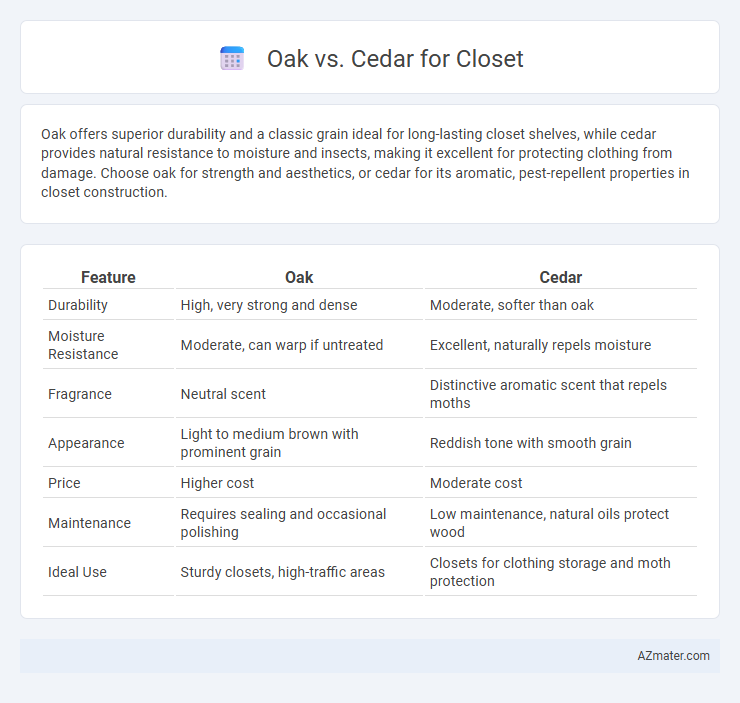Oak offers superior durability and a classic grain ideal for long-lasting closet shelves, while cedar provides natural resistance to moisture and insects, making it excellent for protecting clothing from damage. Choose oak for strength and aesthetics, or cedar for its aromatic, pest-repellent properties in closet construction.
Table of Comparison
| Feature | Oak | Cedar |
|---|---|---|
| Durability | High, very strong and dense | Moderate, softer than oak |
| Moisture Resistance | Moderate, can warp if untreated | Excellent, naturally repels moisture |
| Fragrance | Neutral scent | Distinctive aromatic scent that repels moths |
| Appearance | Light to medium brown with prominent grain | Reddish tone with smooth grain |
| Price | Higher cost | Moderate cost |
| Maintenance | Requires sealing and occasional polishing | Low maintenance, natural oils protect wood |
| Ideal Use | Sturdy closets, high-traffic areas | Closets for clothing storage and moth protection |
Introduction to Oak vs Cedar for Closets
Oak offers exceptional durability and a dense grain structure, making it a popular choice for long-lasting closet construction. Cedar is renowned for its aromatic properties and natural resistance to insects and moisture, providing an effective protective environment for stored garments. Selecting between oak and cedar depends on whether durability or natural pest resistance and fragrance is the primary priority for your closet.
Key Characteristics of Oak Wood
Oak wood is highly valued for its durability, strength, and prominent grain patterns, making it an excellent choice for closet construction. Its natural resistance to moisture and insect damage ensures long-lasting performance in varied environments. Oak's warm, rich hues ranging from light tan to deep brown add timeless elegance and increase the aesthetic appeal of any closet.
Unique Qualities of Cedar Wood
Cedar wood naturally repels moths and insects, making it an ideal choice for closet linings to protect clothing from damage. Its aromatic properties release a pleasant scent that enhances the freshness of stored items while also acting as a natural deodorizer. Unlike oak, cedar has a softer texture and better moisture-wicking abilities, which help prevent mold and mildew in enclosed spaces.
Durability and Strength Comparison
Oak offers superior durability and strength compared to cedar, making it ideal for closet construction where longevity and resistance to wear are crucial. Its dense grain and hardness provide enhanced load-bearing capacity, ensuring shelves and hanging rods remain sturdy over time. Cedar, while softer and less durable, excels in natural resistance to moisture and insects but may dent or scratch more easily under heavy use.
Natural Resistance to Pests and Mold
Oak exhibits a natural resistance to pests and mold due to its dense grain structure and high tannin content, making it a durable choice for closets. Cedar is renowned for its aromatic oils that repel moths, insects, and inhibit mold growth, providing a protective environment for stored clothing. Both hardwoods offer effective natural defenses, but cedar's scent enhances pest deterrence.
Aromatic Benefits and Scent Differences
Oak offers a subtle, earthy aroma that helps maintain a fresh closet environment without overwhelming the senses, making it ideal for those sensitive to strong scents. Cedar is renowned for its potent, natural aromatic oils that repel moths and insects, providing both fragrance and protection for stored clothing. The intense, warm scent of cedar contrasts with oak's mild fragrance, offering distinct benefits depending on the desired level of aroma and pest deterrence.
Maintenance and Longevity
Oak closets offer exceptional durability with natural resistance to wear and dents, requiring minimal maintenance such as occasional dusting and polishing to preserve their rich grain and color. Cedar closets provide excellent moisture resistance and repel insects like moths, making them ideal for prolonged storage of clothing, though they need periodic airing to maintain their aromatic oils. Both woods ensure long-lasting closet structures, but oak generally demands less frequent upkeep while cedar delivers unique preservation benefits for fabrics.
Aesthetic Appeal and Grain Patterns
Oak offers a classic aesthetic appeal with its prominent, open grain patterns and warm honey to reddish tones, creating a timeless look for closets. Cedar features a distinct reddish hue with tight, straight grain patterns and natural knots, providing a rustic and aromatic charm ideal for closet spaces. Both woods enhance closet designs, but oak's bold grain contrasts with cedar's smoother, aromatic texture for diverse visual preferences.
Cost Considerations and Affordability
Oak closets typically cost more upfront due to the hardwood's density and durability, with prices ranging from $40 to $80 per square foot. Cedar offers a more affordable option, generally priced between $25 and $50 per square foot, while providing natural resistance to moisture and pests. Cost-effectiveness depends on budget constraints and long-term investment, as oak's longevity might reduce replacement expenses compared to cedar's initial savings.
Choosing the Best Wood for Your Closet
Oak offers exceptional durability and a distinctive grain pattern, making it ideal for heavy-use closet structures that require long-lasting strength and a classic look. Cedar naturally repels moths and insects while emitting a pleasant aroma, providing built-in protection for clothing and a fresh scent that enhances closet spaces. Choosing between oak and cedar depends on prioritizing either robust structural integrity or natural pest resistance and fragrance for your closet design.

Infographic: Oak vs Cedar for Closet
 azmater.com
azmater.com